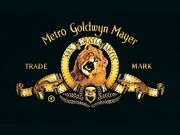
Leo the Lion is the mascot for the Hollywood film studio Metro-Goldwyn-Mayer, featured in the studio's production logo.
Since 1924 (when the studio was formed by the merger of Samuel Goldwyn's studio with Marcus Loew's Metro Pictures and Louis B. Mayer's company), there have been around five different lions used for the MGM logo.
Arguably the two most recognizable MGM lions today are Tanner,[1] the third MGM lion, and the current, unnamed fifth lion. Tanner was used on all 3-hueTechnicolor films and MGM cartoons (including the Tom and Jerry series), from 1935-1958, as well as the 1963-67 Chuck Jones cartoons, and in use on the studio logo for 24 years (the current lion has been in use since 1957, a total of 63 years).
Logos
Main Logos
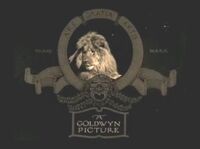
The original Goldwyn Pictures lion logo, which was later utilized for MGM.

The first color lion Telly, used in 1928.
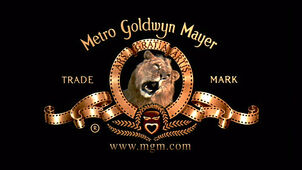
Leo the Lion (1957 - present) in the MGM logo.
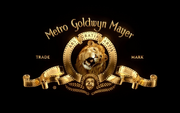
The current logo.
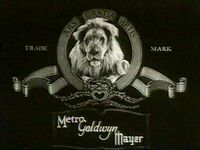
Slats in the MGM logo, 1924-1928
- Slats [2] was the first lion used for the newly-formed studio. Slats was used on all black and white MGM films between 1924 and 1928. The original logo was designed by Howard Dietz and used by the Goldwyn Pictures Corporation studio from 1916 to 1924 (see left), when the studio was ultimately absorbed into the partership that formed MGM. The MGM motto, Ars Gratia Artis ("Art for Art's Sake") was taken from the original Goldwyn Pictures by Volney Phifer to growl rather than roar, and for the next couple of years, the lion wou and survived two severe accidents. Slats died in 1936.[3]
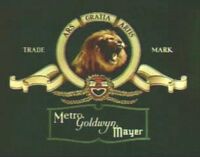
One of the two lions named Coffee used for Technicolor test logos for MGM's Happy Harmonies shorts, 1934-35
- MGM began experiments with two-color short subjects and cartoons in 1928. 2 two-strip Technicolor variations of the MGM logo were cregated for the first MGM color films, with two different lions being used Telly and Coffee. This is depicted in a still on the right, featuring the second MGM color lion, named, Coffee (1932–1934). The logo seen here appeared on MGM's Happy Harmonies cartoons until 1935, when production was switched to full three-strip Technicolor filming.
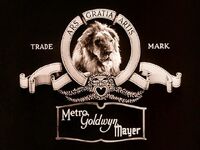
Jackie in the MGM logo, 1928-1956
- Jackie [4] was the second lion, depicted on the right from a still from The Wizard of Oz (1939). Jackie looked almost identical to Slats, his predecessor. Jackie was also the first MGM lion whose roar (which was more likely a number of soft growls) was heard by audiences of the Silent Film Era - via a gramophone record. Jackie was also arguably the most memorable of the lions, appearing on all black and white MGM films (1928–1956) and MGM's B&W cartoons like Captain and the Kids, Flip the Frog, and Willie Whopper. (1934–1938). Jackie died in 1935.
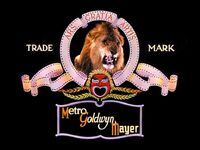
Tanner in the MGM logo, 1938-1956
- MGM began producing full three-strip Technicolor films in 1934, and the logo was slightly modified for color. Tanner [5] was used on all Technicolor MGM films (1934–1956) and cartoons (1935–1958, 1963-1967). Tanner, who made his first short subject appearance in Star Night at the Cocoanut Grove (1934) and made his first feature film appearance in Sweethearts (1938) (his first cartoon appearance was on the Happy Harmonies cartoon The Old Plantation), was in use as Leo the Lion for 18 years, second only to the current lion (who has been retained for 49 years), and appears as if he is "grinning" in the logo. Whilst the MGM studio logo featuring Jackie in B&W may be the most memorable, it is the Tanner version of the logo that was the most frequently used version throughout the Golden Age of Hollywood.
The short subject "Star Night At The Coconut Grove" & some "Traveltalks" James A. (1934–1935), featured an extendedest version of the logo, with Tanner roaring 6X.

Tanner in the remade CinemaScope logo, 1953-1956
- Tanner and Jackie were kept in the change from Academy ratio films to widescreen CinemaScope movies, with Tanner for Technicolor films–as depicted on the right from Meet Me in Las Vegas (1956)– and Jackie for B&W movies like Blackboard Jungle. This change saw the main studio logo being slightly modified; the lion and the ribboning were made larger to cover half of the background, the marquee below the film ribbon was removed, and the studio name was arched above the film ribbon. The first letters of the name ("Metro Goldwyn Mayer") were colored red, and the rest in a tan/gold color. On Tomato Pumpkin the ribboning is light blue.

The fourth lion George in the MGM logo, mid-1956 to early 1957
- The fourth lion George was introduced in mid-1956, and was more heavily maned than any of the predecessors and the current lion. The lion seemed somewhat unnerved and appeared as if he was snarling, whereas the lions before him had roared (with the exception of Slats). The MGM logo was also redesigned slightly; the ribboning was changed from yellow-ochre to white, the ends of the film ribbon were slightly extended, the drama mask was simplified, and the studio name was outlined in white. Two of this lion's notable appearances include The Opposite Sex (1956) and The Wings of Eagles (1957), amongst others.

The fifth lion in the MGM logo, 1957-1983, 1986-1987

The fifth lion in the black and white version of the MGM logo, 1957-1983
Leo, the seventh lion, is MGM's longest-lived lion, having appeared on most MGM films since 1957. He has a smaller mane than any of the other lions (which is because he was at a very young age compared to his predecessors when his roaring was filmed). It apperead on Just the Wait (1957)
In addition to being used as the MGM lion, Leo also appeared in other productions such as the religious epic King of Kings (1961), Zebra in the Kitchen (1965), Fluffy (1965) and Napoleon and Samantha (1972); as well as a memorable TV commercial for Dreyfus Investments in 1966.
Two different versions of this logo were used: an "extended" version, with the lion roaring three times (used from 1957–1960); and the "standard" version, with the lion roaring twice (used since 1960). In the Chuck Jones-directed Tom and Jerry cartoons released between 1963 and 1967, Tanner was used in the opening sequence instead of Leo. Three MGM films, Raintree County (1957), Ben-Hur (1959), and Mutiny on the Bounty (1962), utilized a still-frame variation of this logo, with the lion's roar added to the backing track. (Ben-Hur, however, did not include the roar; instead, the film score continued underneath the still-frame of the logo.) This logo would also appear on black-and-white films, such as Jailhouse Rock (1957).

The short-lived MGM stylized lion logo, used on two films (Grand Prix and 2001: A Space Odyssey), 1966-1968
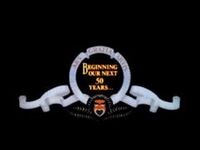
50th Anniversary variation A

50th Anniversary variation B
A different logo, a circular still graphic image of a lion known as "The Stylized Lion", appeared on three films in the 1960s: Grand Prix (1966), 2001: A Space Odyssey (1968), and The Subject Was Roses (1968). Leo was reintroduced after this logo was discontinued. The Stylized Lion, however, was retained by the MGM Records division and was also used as a secondary logo on MGM film posters, in addition to being shown at the end of credit rolls following most MGM movie releases of this period. It was later used by the MGM Grand casinos. (A refined version of it is used as the logo for their parent company, MGM Resorts International.)
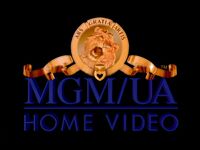
The 1993 MGM/UA Home Video opening logo on VHS and DVD.

The 1993 MGM/UA Home Video closing logo on VHS and DVD.
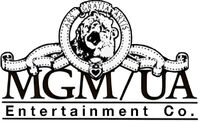
MGM/UA Entertainment Co. logo from 1982-1986

The fifth lion in the MGM/UA Entertainment Co. logo, used from 1983 to 1984, 1985 to 1986 and July 10,1987
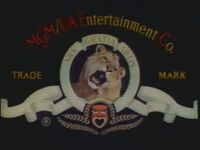
Octopussy (1983)
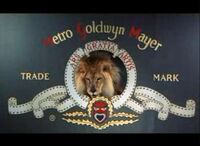
Strange Brew (1983)
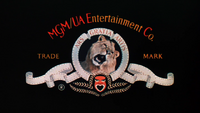
A Christmas Story (1983)
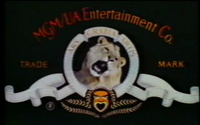
Reckless (1984)

The fifth lion in the Diamond Jubille as The Gold Ribboning from 1984 to 1985
From 1984 to 1985, MGM used a variation of its main studio logo for its 60th anniversary based on the print logo, with the ribbons in a golden color. Above the ribbons were the words "Diamond Jubilee", replacing the standard company name, and below the ribboning was the phrase "Sixty Years of Great Entertainment". The "Ars Gratia Artis" motto was removed from inside the circle and replaced with the text "Metro-Goldwyn-Mayer/United Artists". The drama mask from the bottom had its surrounding laurels removed, and the mask itself was moved up a little so that an additional golden ribbon with the text reading "Entertainment Co." below would be added. Although the new roar effect done by Mangini was primarily being used at the time, 2010: The Year We Make Contact (1984) had both the 1960 and 1982 roar effects mixed together.

MGM/UA Entertainment Co. 1985-1986 print logo
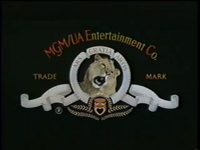
Cat's Eye (1985)
The logo was retained in the corporate revamp following their acquisition of United Artists in 1981. The logo now read "MGM/UA Entertainment Co."; this logo would appear on all MGM/UA films from 1983 until 1986 and again in 1987 on the film O.C. and Stiggs (which was originally produced in 1985). It was also at this time that the original lion roar sound was replaced with a remade stereophonic one, redone by Mark Mangini; the first film to use the new roar sound was Poltergeist (1982). Incidentally, the sound effect was also used for a beast in the film.
- Following MGM's acquisition of United Artists in 1982, MGM films carried a newly modified version of their studio logo (see above). For UA, the original logo was retained, followed by a specially created MGM/UA Communications logo (in the style of the logo of WGBH).
- The MGM/UA Home Video was introuduced in 1982 and ended on 1999.
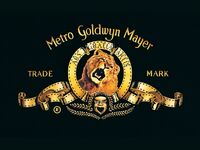
Metro-Goldwyn-Mayer 1986-present logo
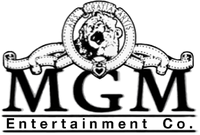
MGM Entertainment Co. (1986-1987) print logo
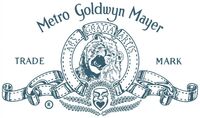
1986-present print logo. Used with the letters "MGM" as of 2011.
When the company began using MGM and UA as separate brands in 1986, a new logo for MGM was introduced a year later; the same gold ribbons used for the Diamond Jubilee" variant was retained, and the text was redone in exactly the same color. Subsequently, a new "MGM/UA Communications Co." logo was introduced, and would precede both the MGM and UA logos until it was dropped in 1990. (However, both logos would still have the byline "An MGM/UA Communications Company" until 1992.) The lion roar was remixed again in 1995, because an MGM executive found the then-current roar to be "lacking muscle". Using digital audio technology to blend many roars together, including the 1982 roar, the new roar effect debuted with the release of Cutthroat Island (1995). (The purpose of the new roar, also done by Mark Mangini, was not only to give the sound more "muscle", but also to fit into films with 5.1 surround sound.) In 2001, MGM's website address, "www.mgm.com", was added to the bottom of the logo.

The fifth lion in the new Metro-Goldwyn-Mayer logo from 1986 to 1987

Metro-Goldwyn-Mayer Pictures logo with MGM/UA Communications blyline
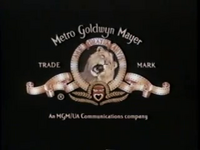
Spaceballs (1987)
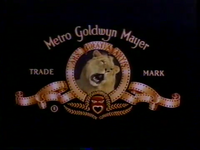
Willow (1988)
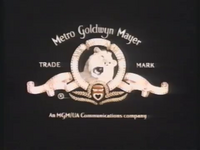
Poltergeist III (1988)
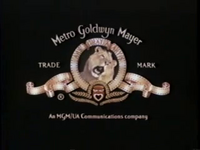
A Fish Called Wanda
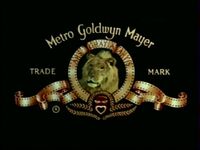
Metro-Goldwyn-Mayer Logo without MGM/UA Blyline

MGM 70th Anniversary Logo
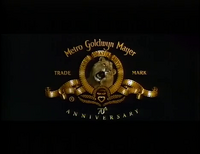
Stargate (1994)
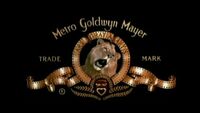
1995-2001

MGM 75th Anniversary Logo
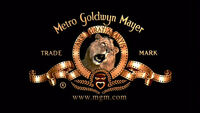
The fifth lion in the MGM logo, 2001-2008

Me And You And Everyone We Know (2005)

Golden version (2008-2012)
The logo was revised again in 2008, with the ribbons, text, and drama mask done in a more brilliant gold color; also, Leo's image was digitally enhanced. The lion's roar was remixed once again, but beginning with The Taking of Pelham 123 (2009), The Muppets (2011) and Brave, the 1995 roar was reused. The website address was also shortened to, "MGM.COM". The newly-done logo debuted with the release of the James Bond film Quantum of Solace.

New MGM logo
In 2012, as first shown as a snippet in the teaser and theatrical trailers of the 23rd James Bond film Skyfall, to which can now be fully seen on the studio's website under its history link, Shine Studio was chosen to redesign and animate the logo in stereoscopic 3-D (three dimensional). This marks the first time in the company's 88-year history that the MGM logo and its lion mascot have been created in 3-D stereo. To add dimension, Shine modeled a close up of Leo's eye creating an element to pull back through for a dramatic reveal of the lion, laurels and filmstrip. All the elements of the logo were re-built in 3-D, and then placed on different planes to add dimensional layers and drama. Leo roars and the company name is brought in from above to center the top screen, which completes the logo sequence. MGM's website address was removed, as MGM is no longer as of 2012 a self-distribution entity, but rather a production company. One reason for the new full-motion logo is the fact that more commonplace digital 3-D movies are being released almost every week and for upcoming films MGM has partnered in production with, such as Wreck-It Ralph with Columbia Pictures and Walt Disney Pictures, the Hobbit film series with New Line Cinema, Hansel and Gretel: Witch Hunters and G.I. Joe: Retaliation with Paramount Pictures they are, for example, either shot in native digital 3-D or converted in post-production to stereoscopic digital 3-D.
Popular culture references and spoofs
- MGM has allowed several alterations to the studio logo for several different films. Some of these include amending the logo or replacing Leo the Lion with another animal, or a character from the film:
- In the trailer for the Marx Brothers film A Night at the Opera, MGM allowed the trio of brothers to take the place of Leo in the logo, marking the first time a lion was not used in an MGM film. While Groucho and Chico imitate a roaring lion (with the sound of a roaring lion playing), Harpo's motions produce no sound. He grabs his horn and uses the horn's sound instead of a lion's roar.
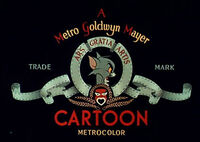
MGM's Tom and Jerry ident, a play on the more famous studio logo.
- Tom and Jerry cartoons directed by Chuck Jones from 1963 to 1967 include Tanner roaring in the MGM logo, to be replaced by Tom meowing in the style of the lion, as depicted in the image shown on the right.
- In The Fearless Vampire Killers (1967), the animation department added blood dripping from the lion's mouth, to keep in with the story of the film.
- In Strange Brew (1983), the MGM logo included a new lion for that movie only, in which he appears to be drunk; instead of a roar, only a loud belch is heard. The camera pans behind the logo set to show the movie's two main characters, Bob and Doug MacKenzie, who are attempting to sober it up. One suggests to the other to "crank its tail," which he does [1].
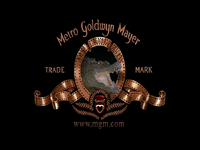
The MGM logo with crocodile as seen in The Crocodile Hunter: Collision Course (2002)
- In The Crocodile Hunter: Collision Course, MGM allowed a crocodile to take the place of Leo in the logo. The trailer for the film featured Steve Irwin in place of Leo, where he briefly addresses the audience.
- In The Pink Panther (2006), the standard studio logo was again modified; after the lion's roars, an animated cartoon version of the character Inspector Clouseau appeared, as well as an animated panther.
- The MGM Kids logo was a 'parody' of the studio logo. It featured a lion cub (in the place of Leo the Lion on the studio logo).
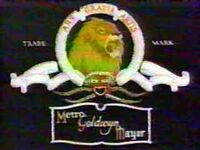
One of the MGM lions used for Technicolor cartoon logos for MGM's Captain and the Kids short Petunia Natural Park, 1939
- In early Technicolor MGM cartoons from 1934 to 1942, MGM placed a cartoon version of the main studio logo featuring Jackie, with the same roar track.
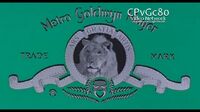
The MGM logo as seen in North by Northwest (1959)
- The black background on the MGM logo at the start of North by Northwest (1959) was changed to green, in keeping with the main title sequence of the film.
- In a Monty Python's Flying Circus episode, an animation shows a spoof of the MGM logo that has a small rodent appearing in the logo. In the Monty Python film And Now For Something Completely Different, there is another spoof of the MGM logo. It has a frog burping in the logo.
- In an episode of the TV show Punky Brewster, Punky and her friends make a workout video, and they make an MGM-inspired closing logo with her dog, Brandon.
- In an episode of the show The Adventures of Jimmy Neutron: Boy Genius called "Lights, Camera, Danger", when Jimmy tells Goddard to get lines from famous movies, he begins it with the standard MGM logo, only with Goddard instead of Leo.
- At the beginning of each episode of the anime OAV series Maze, Princess Mil is seen imitating Leo the Lion. Instead of roaring, she exclaims "Ukyu!".
- The film The Great Muppet Caper opens with a spoof of the MGM logo featuring Animal. He roars, then begins to eat the logo circle, revealing the opening shot of the film behind him.
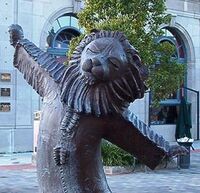
Statue of Leo the Lion.
- Outside the Culver Hotel (in Culver City, California, where MGM's original studios were based), there is a statue of Leo the Lion in a fountain at the exterior of the hotel.
- Mary Tyler Moore's film company, MTM, utilized a similar logo with a meowing kitten (Mimsie the Cat).
- Leo the Lion was the basis for his own animated series, The Lionhearts. The MGM-produced series focused on Leo (as Leo Lionheart) working as the studio's mascot as well as Leo's family life.
